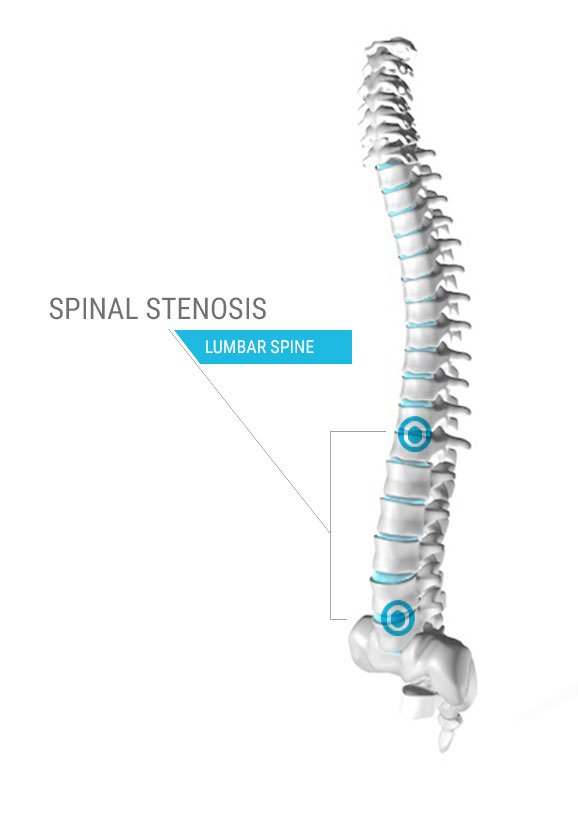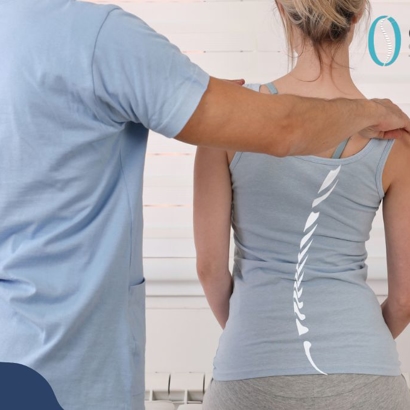
Spinal Stenosis Treatment in Tampa
Spinal stenosis is a condition that causes narrowing of the spinal canal leading to compression of the spinal nerves and spinal cord. It can occur in any region of the spine, but most often occurs in the lower or lumbar, and upper or cervical regions, causing chronic back and neck pain.
The spine is made up of vertebrae that help protect the spinal cord and nerves as well as function to balance, move and hold up the body. Your spinal cord and nerves run along an open space in the back, or posterior, portion of each vertebra called the spinal canal.
The spinal canal is a large central passage that protects the sensitive spinal cord and nerves as they extend along the body carrying information to and from the brain like a major highway.
Spinal stenosis occurs when this canal starts to narrow, putting pressure on the spinal cord and impinging on the nerve roots. This narrowing can be caused by the development of bony growths, osteoarthritis or other degenerative changes in the spine.
If left untreated, stenosis can lead to myelopathy or bruising of the spinal cord. Myelopathy is progressive and can have life long effects, including paralysis.
Call (727) 300-2537 or contact us online to schedule an appointment and learn more about spinal stenosis treatment in Tampa.
What are the Symptoms of Spinal Stenosis?
Although the most common symptom of spinal stenosis is pain, some patients may experience no symptoms. For the patients who do feel pain, the top complaints are sciatic pain, radiating pain, weakness, numbness, tingling, pins and needles, stiffness, and pain that changes with standing and sitting.
The symptoms of spinal stenosis often correlate directly with the region of the spine damaged by the narrowing. For example, a patient diagnosed with spinal stenosis in the lumbar spine could experience chronic lower back pain or radiating pain the in buttocks and legs.

Spinal Stenosis Symptoms Include:
- Back Pain
- Radiating Pain
- Weakness
- Numbness
- Sciatic Pain
- Tingling
- Pain While Walking
- Pain When Bending Backward
- Loss of Bladder
- Loss of Bowel Control
What Causes Spinal Stenosis?
Spinal stenosis is most often caused by the simply getting older, as the narrowing of the spinal canal is part of the natural aging process. Aging causes degeneration of the cartilage in the spinal joints resulting in bone spurs. Soft tissue such as the ligamentum flavum buckling or extruded disc material or combinations thereof can be a cause.
Depending on location of the compression on the vertebra, it is divided into vertebral canal stenosis (central stenosis) and lateral stenosis, where the nerve root exits. Spinal stenosis could also occur with postural changes, scoliosis or after playing “collision” sports such as football where you can find “Spear tacklers spine”. In rare cases, it can also be present at birth, called inherited or congenital spinal stenosis.
Spinal stenosis can be caused by a variety of conditions or risk factors:
- Natural Aging
- Acute Injury or Trauma
- Repetitive Motion
- Degenerative Disc Disease
- Arthritis or Osteoarthritis
- Spondylolisthesis
- Poor Posture
- Obesity or Poor Health
- Smoking
- Tumor, Cancer or Infection
- Participation in Impact Sports
- Previous Injury or Spine Surgery
Where on the spine is stenosis most often diagnosed?
Stenosis in the Lumbar Spine
The lumbar region is more susceptible to spinal stenosis than the cervical and thoracic regions because these vertebrae carry the most pressure making them more likely to degenerate over time.
PATIENTS COMPLAIN OF:
- sciatica or radiating pain in buttocks, legs or feet
- chronic lower back pain
- stiffness in the back
- weakness, tingling, burning pain
- more discomfort while standing than sitting
- pain while walking, especially long distance
Stenosis in the Cervical Spine
Spinal stenosis of the cervical spine is less common than the lumbar spine, however if left untreated, it can lead to myelopathy causing life-long effects. Stenosis of the cervical spine is often characterized by:
PATIENTS COMPLAIN OF:
- chronic neck pain
- radiating pain that travels into the arms or hands
- numbness in shoulders, arms, or hands
- headaches or pressure at the base of the skull
Stenosis in the Thoracic Spine
Although stenosis in the thoracic spine is extremely uncommon, it is possible. It is most often caused by aging and indicators include:
PATIENTS COMPLAIN OF:
- sharp pain in the mid-back
- difficulty moving torso side to side
- pain in ribs or internal organs
- pain while coughing or sneezing
- tingling or pins and needles
- pain in legs or difficulty walking
- bowel or bladder dysfunction
-
Minimal Wait TimeYou shouldn't have to wait a profound amount of time to see a physician we'll get you in, in two weeks or less.
-
Education Is KeyWe believe in educating our patients so they feel empowered when making decisions about their care.
-
4 Convenient LocationsWe are easily accessible with 4 locations that are able to provide the same quality of care.
-
Multi-Specialty PracticeWe pride ourselves on providing our patients with care from physicians who specialize in their needs.
How is spinal stenosis diagnosed?
Patient history and current physical exam should suggest if the possibility that spinal stenosis is causing the back and/or leg pain. Plain films (xrays) analysis of the spine is an efficient and inexpensive means of the initial evaluation of spinal stenosis. In a patient with degenerative spinal stenosis xrays are not specific enough to allow treatment decisions.
A myelogram in conjunction with CT scan (computed tomography) are used to obtain images in different positions. An MRI (magnetic resonance imaging) provides images in all planes and of the entire lumbar and lower thoracic areas. An MRI also provides information about soft tissue structures and bone marrow changes. Clinical correlation is very important in the diagnosis of spinal stenosis.
How is spinal stenosis treated?
Most patients with lumbar spinal stenosis can be treated non-surgically. We believe patients should be educated to understand the goal of therapy and have realistic expectations. Treatment begins with the simplest mode of therapy, such as temporary limitations of physical activities and non steroidal anti-inflammatory drugs (nsaids).
If no improvement occurs over a 3-6 week period, a change in the type of anti-inflammatories or a trial of epidural steroid injections may be considered. Patients with stenosis rarely respond to braces. However, when degenerative spondylolisthesis or degenerative scoliosis exists, this may be a worthwhile treatment alternative.
Physical therapy has variable affects, but should be considered as the next step. Patients who do not respond to conservative treatments may be candidates for surgery.
- Heat and Ice
- Physical Therapy
- Stretching
- Exercise
- Chiropractic Care
- Epidural Steroid Injections
- OTC Medication such as ibuprofen to reduce inflammation
- Muscle Relaxants to calm muscle spasms
- Narcotics or Opioids short term as they can be habit forming and lose effectiveness over time as patient develops tolerance.
Surgery for Spinal Stenosis
If conservative care such as physical therapy, injections, medication or exercise are not reducing the symptoms and relieving the pain associated with spinal stenosis, surgery may be an option. Most spinal stenosis cases can be fixed with a minimally invasive procedure. It is important to note that foraminal stenosis is often overlooked and can be the cause of failed back surgery syndrome.
Follow up studies show that over time, many patients will again become symptomatic even after an initial successful surgery. This finding suggests that the degenerative process continues and the continuation should be explained to the patient before surgery.
Frequently Asked Questions
How long does spinal stenosis recovery take?
Recovery time varies depending on the severity of the condition and the type of treatment received. Conservative treatments, like physical therapy and medication, may take several weeks or months to improve symptoms. Surgical recovery can take longer, often several months.
Can spinal stenosis cause numbness or weakness in the legs?
Yes, spinal stenosis can cause numbness or weakness in the legs, especially when walking or standing for long periods. This is due to pressure on the nerves in the spinal canal.
Is spinal stenosis more common in certain age groups?
Spinal stenosis is more common in older adults, as the spine naturally degenerates over time. However, injury or certain medical conditions can also affect younger individuals.
The Latest In Orthopedics
-
 The Case for Epidural Steroid Injections
The Case for Epidural Steroid InjectionsDiscover Relief with Epidural Steroid Injections Living with chronic spinal pain can be exhausting, impacting every ...
Read More -
 Innovative Treatments for Back Pain: Exploring the Latest Advances in Spine Care
Innovative Treatments for Back Pain: Exploring the Latest Advances in Spine CareInnovations in Back Pain Treatment for a Healthier Future Dealing with back pain can take a toll on every aspect of your ...
Read More -
 What Is Spinal Cord Stimulation?
What Is Spinal Cord Stimulation?Spinal cord stimulation (SCS) is a cutting-edge technique that leverages electrical impulses to mitigate chronic pain. ...
Read More -
Understanding Workers' Compensation for Spine Injuries: A Guide for Employees
If you've suffered a spine injury on the job, workers' compensation could be a vital lifeline. This government-mandated ...
Read More


.2408222022228.png)